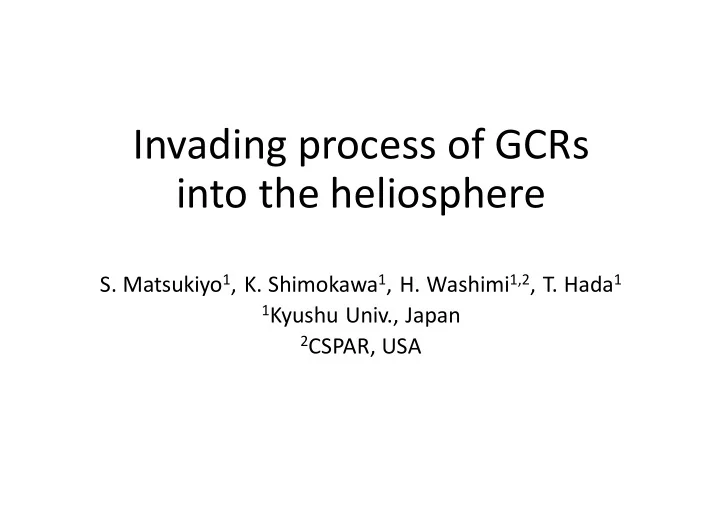

Invading process of GCRs into the heliosphere S. Matsukiyo 1 , K. Shimokawa 1 , H. Washimi 1,2 , T. Hada 1 1 Kyushu Univ., Japan 2 CSPAR, USA
Background Solar modulation of CR spectrum Remarkable for E < a few 10 GeV Anisotropy for TeV CRs Effect of convected spiral SW B field Effect of large scale structures (TS, HP) Effect of wave-particle interactions NASA Effect of non-stationarity of SW … Yuan [2018] Abbasi et al. [2010]
Background Past approach Diffusion-convection eq. based Yuan (2018), Aloisio et al. (2015), Yamazaki et al. (2015), … Test particle simulation + global MHD simulation Lopez-Barquero et al. (2016, 2017), … ∆ = 20 AU 3500 AU
Purpose To understand detailed process of GCR P T invasion into the heliosphere and further into the Earth To reveal energy dependence of the invasion process Approach: V B Test particle simulation + high resolution global MHD simulation ( ∆ = 0.2 AU) Washimi et al. [2015]
Test particle simulation + MHD simulation : 9 Test particle simulation using � , � fields particles 8 reproduced by MHD simulation �� � �� � � � � � � �� � � � � , �� � � � # particles � 10 � No waves/turbulence $ %&' � 3)" # %&' � 23+,/. Initial distribution function $ &4 � 35)" / %&' � 0.1/cc -- uniform on a sheet at a certain � # &4 � 400+,/. 1 %&' � 63003 in interstellar space / &4 � 5/�� -- monoenergetic jet along local � field &4 � 10 7 3 1 � � 10, �100 1000 at 1AU �~ 10"�#, �100 "�# 1000"�# provided by Washimi
Field lines L1: draping $ %&' connected to spiral $ &4 L2: spiral $ &4 L3: draping $ %&' B/B ISM Y=0 Z=0
Field structure : 9 Bow shock, heliopause, termination shock are reproduced. The above discontinuities and SW current sheet form current layers. J B
Particle behaviors ( γ � 10 ) Most of particles follow L3 field lines and pass outside the HP or are mirror reflected at the HP Some particles come in and out of the heliosphere when they come close enough to the heliopause along the draping IS B field lines A part of them reach the inner boundary (r = 50AU) of the polar region Very few particles reach the inner boundary after a short time (weeks) Y Z Z Z=0 Y=0 X=0 X X Y
Particle behaviors ( γ � 10 ) Direction of field felt by a particle changes when it crosses the HP. The particle stays near current sheet for a long time. < � � 0.013 Distance from the sun
Particle behaviors ( γ � 1000 ) Direction of field felt by a particle changes when it crosses the HP. They do not stay in the current sheet due to large gyro radii. < � � 1.3 Distance from the sun
Particle behaviors ( γ � 1000 ) Easy to come in and out of the heliosphere due to large gyro radius No mirror reflection for the particular case Particles can reach the inner boundary (r = 50AU) with a short time Some particles coil about the heliosphere even after that most of the other particles flow away. Y Z Z Z=0 Y=0 X=0 X X Y
Statistics Initial particle distribution: # particles reached at inner boundary uniform on a 1/8 sphere velocity shell (uniform pitch angle)
Statistics Energy dependence of anisotropy
Summary Test particle simulation of CR invasion process using EB field obtained by global MHD simulation has been started. Future Issues Detailed analysis of particle behavior will be focused Effect of wave-particle interaction will be incorporated Statistics of particles will be discussed …
Recommend
More recommend